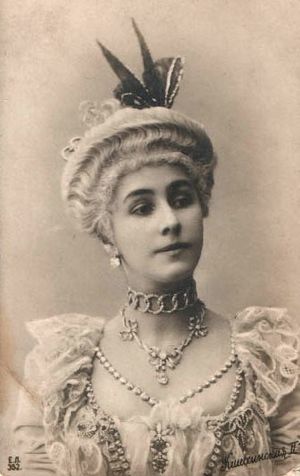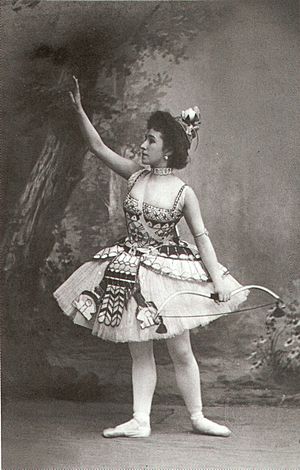Mathilde Kschessinska facts for kids
Quick facts for kids Mathilde Kschessinska |
|
|---|---|
| Princess Romanovskaya-Krasinskaya | |

Kschessinska costumed for the title role in Petipa's La Camargo. St. Petersburg, c. 1902
|
|
| Born | 31 August 1872 Ligovo, Petergof, Russian Empire |
| Died | 6 December 1971 (aged 99) Paris, France |
| Burial | Sainte-Geneviève-des-Bois Russian Cemetery |
| Spouse |
Grand Duke Andrei Vladimirovich of Russia
(m. 1921; d. 1956) |
| Issue | Prince Vladimir Romanovsky-Krasinsky |
| House | Holstein-Gottorp-Romanov |
| Father | Feliks Krzesiński |
| Religion | Russian Orthodox (previously Catholic) |
| Occupation | Prima ballerina |
Mathilde-Marie Feliksovna Kschessinska (Polish: Matylda Maria Krzesińska, Russian: Матильда Феликсовна Кшесинская; 31 August 1872 – 6 December 1971) was a famous Polish ballerina. She came from the noble Krzesiński family. Her father, Feliks Krzesiński, and her brother were also dancers in Saint Petersburg. Mathilde later married Grand Duke Andrei Vladimirovich of Russia, who was a cousin of Tsar Nicholas II of Russia. After her marriage, she was also known as Princess Romanovskaya-Krasinskaya.
In Western countries, she was often called Mathilde Kschessinska or Matilda Kshesinskaya.
Contents
Early Life and Training
Mathilde Kschessinska was born in Ligovo, near Peterhof, in 1872. She was the youngest child of Adam-Felix Kschessinsky and Julie Kschessinska. Her father, who was Polish, came to St. Petersburg in 1853 as a dancer. He performed at the famous Mariinsky Theatre.
When Mathilde was eight years old, in 1880, she joined the Imperial Theatre School. There, she studied ballet with a great teacher named Yekaterina Vazem. On 30 August 1881, she danced for the first time on a big stage in the ballet Don Quixote.
For her graduation exam, Kschessinska performed a special dance called a pas de deux from the ballet La Fille Mal Gardée. Important people, including Tsar Alexander III of Russia and his son Nicholas Alexandrovich, Tsesarevich of Russia, watched her performance. After seeing her dance, the Tsar told her, "Be the glory and the adornment of our ballet." She officially graduated at age eighteen on 22 April 1890.
Becoming a Prima Ballerina
In 1896, Mathilde Kschessinska earned the special title of Prima ballerina of the Saint Petersburg Imperial Theatres. This title means "first ballerina" and is given to the most talented female dancers. The famous ballet master Marius Petipa was not fully in favor of her getting this title. However, Mathilde was an incredibly gifted dancer and also had strong connections at the Imperial Russian Court, which helped her achieve this high rank.
Working with Marius Petipa
Mathilde Kschessinska worked closely with the legendary ballet master Marius Petipa for much of her career. She said that her entire artistic journey, until the arrival of another choreographer named Fokine, was connected to Petipa. One of her favorite roles was in his ballet, La Fille du Pharaon.
Petipa created many roles specifically for Kschessinska in his ballets. These included Le Réveil de Flore (1894), Mlada (1896), Le Roi Candaule (1897), Les Aventures de Pélée (1897), The Pharaoh's Daughter (1898), Harlequinade (1900), and La Esmeralda (1899). She also became very skilled at performing 32 fouettés en tournant, which are difficult spinning turns.
In 1899, Prince Serge Wolkonsky became the Director of the Imperial Theaters. He worked to bring new artists to the theaters, including painters like Alexandre Benois. However, Wolkonsky had a disagreement with Kschessinskaya. She refused to wear a specific 18th-century costume for the ballet La Camargo. This disagreement led to Wolkonsky resigning from his position in 1901.
Life Changes and Moving to France
After the February Revolution began in Russia in 1917, Mathilde Kschessinska was forced to leave her home. Her house was taken over by a political group called the Bolsheviks. She described the situation in Petrograd as a "nightmare world" with many arrests and dangers.
She stayed with friends and family for a while before leaving Petrograd on 13 July. She eventually went to Kislovodsk with Andre, who would later become her husband. As the political situation worsened, she had to flee again to Novorossiysk. On 13 February 1920, Mathilde, her son Vova, and Andre boarded a ship and left Russia. They arrived at her villa in Cap-d'Ail, France, on 12 March 1920.
On 30 January 1921, Andre and Mathilde were married in a Russian Church in Cannes, France. After their marriage, she was given the name Krassinsky and the title of Princess. Her son also received the title of Prince. Later, in 1935, they added the name Romanovsky to their family name.
On 9 December 1925, Mathilde changed her religion from Catholic to Russian Orthodox. In 1929, they moved into a new home in Paris. On 26 March, Kschessinska opened her own dance studio, giving her first lesson a few days later. By 1933, she had more than a hundred students, both boys and girls. Many famous dancers studied with her, including Margot Fonteyn.
Mathilde Kschessinska made her very last stage appearance on 14 June 1936, at the age of 64, during a special performance at Covent Garden.
In 1960, she wrote her life story in a book called Souvenirs de la Kschessinska, which was also published in English as Dancing in St. Petersburg: The Memoirs of Kschessinska. Even though she faced money problems later in life, she remained strong. She passed away in Paris in 1971, at almost 100 years old. She is buried with her husband and son at the Sainte-Genevieve-des-Bois Russian Cemetery.
Cultural Depictions
- Fall of Eagles, a TV show from 1974, where she was played by Jan Francis.
- Anna Pavlova, a film from 1983, where she was played by Natalya Fateyeva.
- Matilda, a film from 2017, where she was played by Michalina Olszańska.
See also
 In Spanish: Mathilde Kschessinska para niños
In Spanish: Mathilde Kschessinska para niños
- List of Russian ballet dancers
Autobiography
- H.S.H. The Princess Romanovsky-Krassinsky. Dancing in Petersburg — London, 1960, 1973.
- S.A.S. La Princesse Romanovsky-Krassinsky Souvenirs de la Kschessinska — Paris, 1960.


